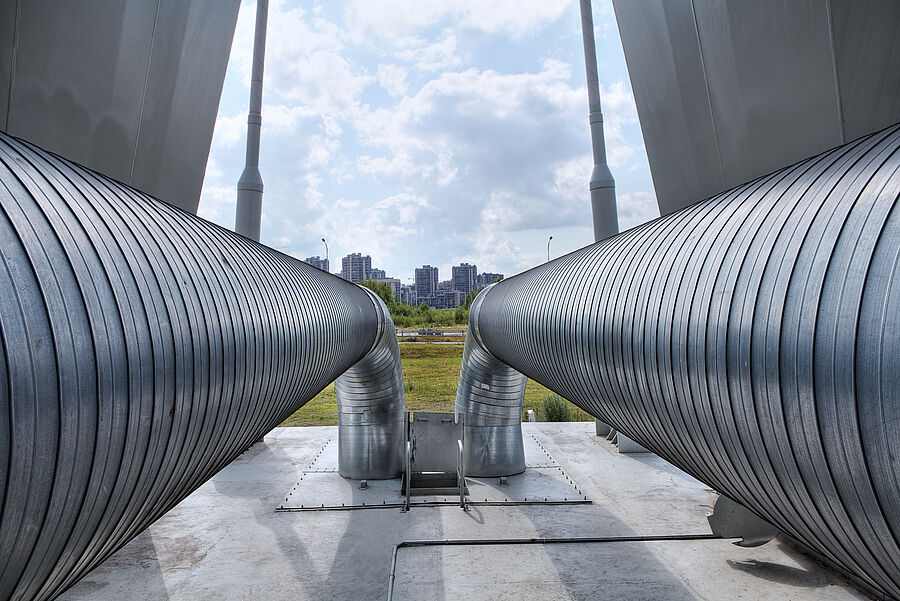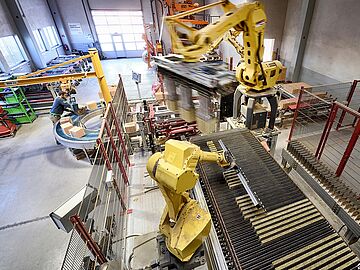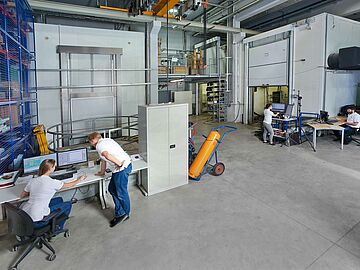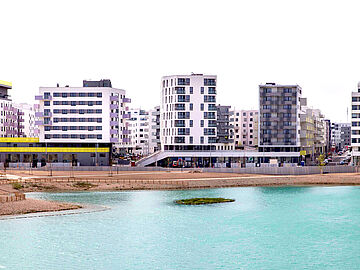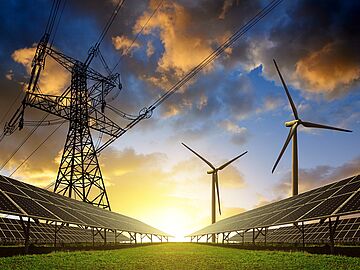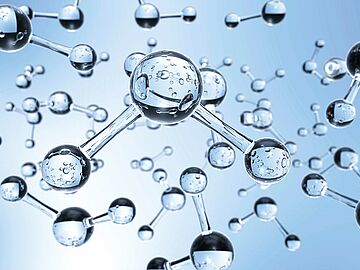Innovative solutions for high heating and cooling requirements in cities and industries
Areas with high heating and cooling requirements, such as densely populated urban areas and large industrial and commercial customers, are currently predominantly reliant on fossil fuels. In order to meet these requirements sustainably in the future, new technologies and concepts are required that can provide large amounts of thermal energy efficiently. This is often not economically and technically feasible for individual consumers, but can offer an efficient and sustainable solution through shared and cascading use in district and local heating networks as well as cooling networks, in combination with thermal storage. Heating and cooling networks in particular play a central role in ensuring a CO2-neutral energy supply by integrating renewable energies and coupling different sectors.
Research and focus areas
Near-surface and deep geothermal energy
Geothermal energy enables the use of geothermal energy for the sustainable and CO2-free supply of heating and cooling for both buildings and industrial applications. This energy source can be optimally utilized by feeding it into thermal networks and cascading it at different temperature levels. Geothermal systems also make it possible to generate sustainable heat for heating and cooling purposes in a climate-neutral way and without emitting aerosols, gases or noise emissions.
- Thermal groundwater utilization, geothermal probe fields and geothermal collectors
- Heat recovery from infrastructure buildings and surfaces (e.g. tunnels, asphalt collectors)
- Potential and feasibility of hydrogeothermal energy
- Hydrochemistry of geofluids
- Innovative concepts and optimal integration into supply systems
Utilization of ambient and waste heat
The use of ambient and waste heat is an essential part of increasing energy efficiency and promoting renewable energies. By integrating these heat sources into thermal networks and using them in cascades, urban areas and industries can be made more sustainable.
- Utilization of ambient heat (air, surface water)
- Waste heat recovery from industry, data centers, electrolysers and H2 or CO2 infrastructure
- Innovative development and integration into thermal networks
- Use of large heat pumps
Thermal storage for heating and cooling
Storage technologies play a central role in making the energy supply more flexible and the efficient use of renewable energies. In the future, large thermal storage systems will be needed to ensure the safe and reliable supply of renewable heating and cooling. Both above-ground and underground heat and cold storage facilities make it possible to store surplus thermal energy on a seasonal basis. For example, geothermal energy that is available all year round can be used in the colder months.
- Aquifer storage
- Geothermal probe storage
- Cavern storage
- Earth basin storage
- Tank storage
- Innovative forms of storage
Materials for a flexible and resilient energy supply
Energy storage (heat, electricity, green gases) can improve the efficiency and reliability of energy systems. For reliable and efficient systems, we need storage materials and components with optimized properties. This includes the characterization and selection of suitable materials as well as the development of innovative applications to maximize energy yield. For new insulation and storage materials as well as geological materials, the measurement of thermal properties and kinetics is crucial for achievable performance and allows further simulations in components and systems. By (further) developing measurement methods, a large number of questions in thermal energy storage, hydrogen or battery technologies can be answered.
- Development of materials, components and systems for energy supply and storage (thermal energy, hydrogen, batteries)
- Method development and characterization of energy storage materials (mass and heat transport, thermophysical properties)
- Process development and system integration
Innovative heating and cooling supply concepts
Our innovative heating and cooling supply concepts aim to make the energy supply in urban areas and associations sustainable and efficient. The use of local heat sources in existing and new supply areas reduces dependency. By implementing low-temperature/energy networks and integrating storage systems, these concepts can make a significant contribution to the energy transition. The available energy sources can be used in the best possible way through the cascading use of energy sources. This creates regional synergies, increases the degree of self-sufficiency and at the same time significantly improves the economic efficiency of the system.
- Solutions for building associations, neighborhoods and urban areas
- Integration of local heat sources and storage
- Cascading use of heating and cooling
Transformation of thermal power plants
The transformation of thermal power plants is an important step towards reducing CO2 emissions and integrating renewable energies. In the future, this will require a range of innovative technologies such as heat pumps, electrical and high-temperature storage, carbon capture and hydrogen as well as power-to-heat and power-to-X-to-power (e.g. Carnot batteries), which are integrated intelligently and optimized into existing infrastructures. Sector coupling plays a central role here in order to create a comprehensive and sustainable energy infrastructure.
- Decarbonization and integration of renewable technologies
- Sector coupling (electricity, thermal energy, renewable energy sources) for a sustainable energy future
Offers and services
Our services cover the entire process from initial concept development to practical implementation:
- Technology comparisons, potential and feasibility studies
- Technology development
- Pre-basic engineering, planning, design and material optimization
- System integration and operational optimization
- Scientific implementation support and operational monitoring and evaluation
- Modelling, simulations and optimization of individual components and entire systemsStationary and dynamic models and simulations (0D-3D)
- Multi-physical, detailed models and simulations
- Experimental investigations and method developmentThermophysical material characterization
- Heat and mass transfer analyses
- Characterization of hydrochemical processes in geofluids
- Development of laboratory prototypes
